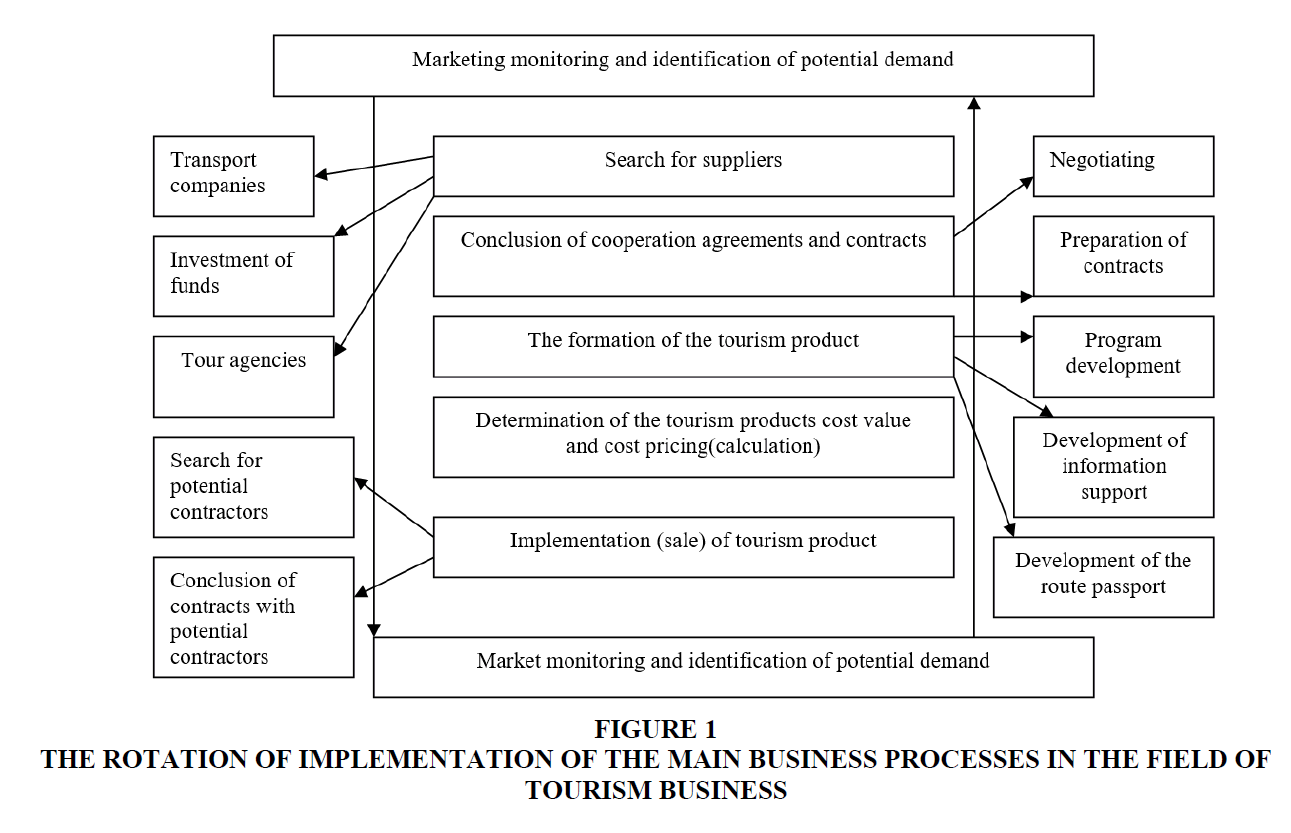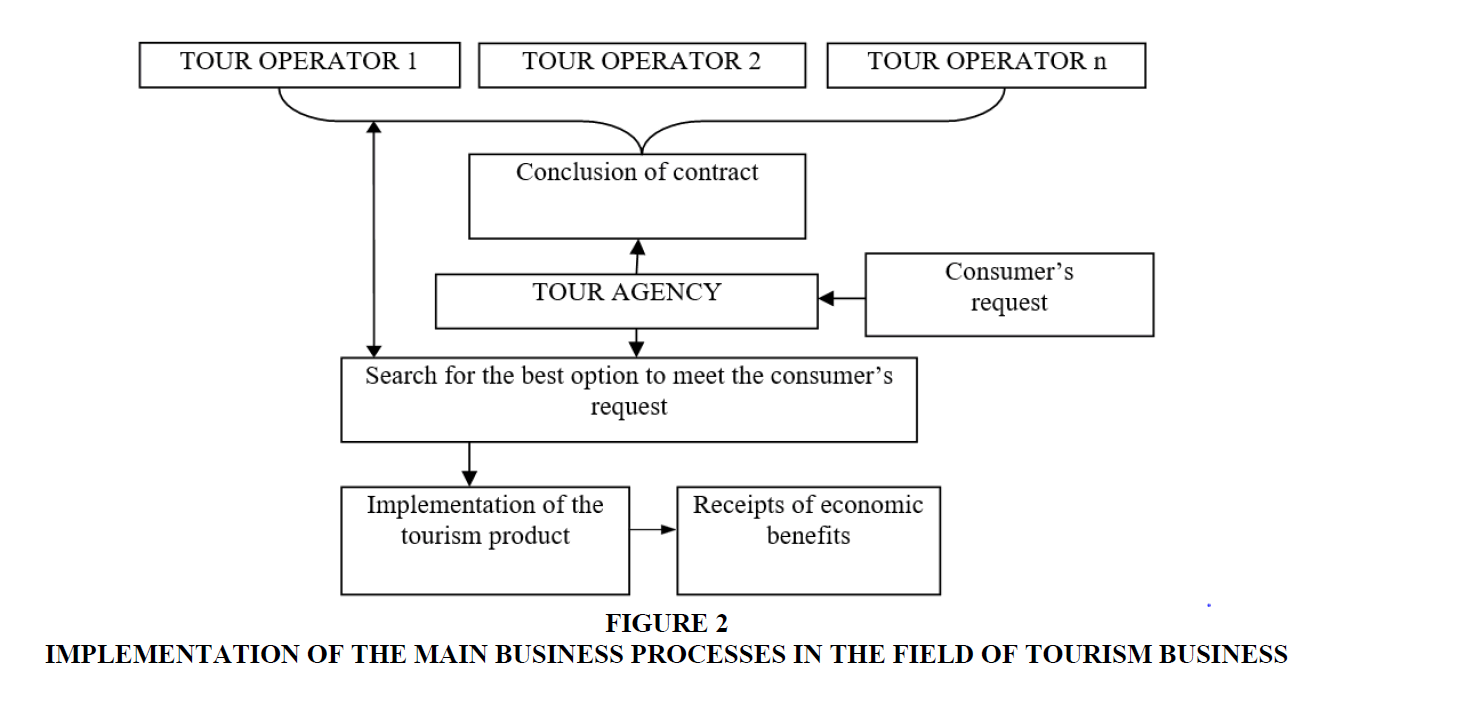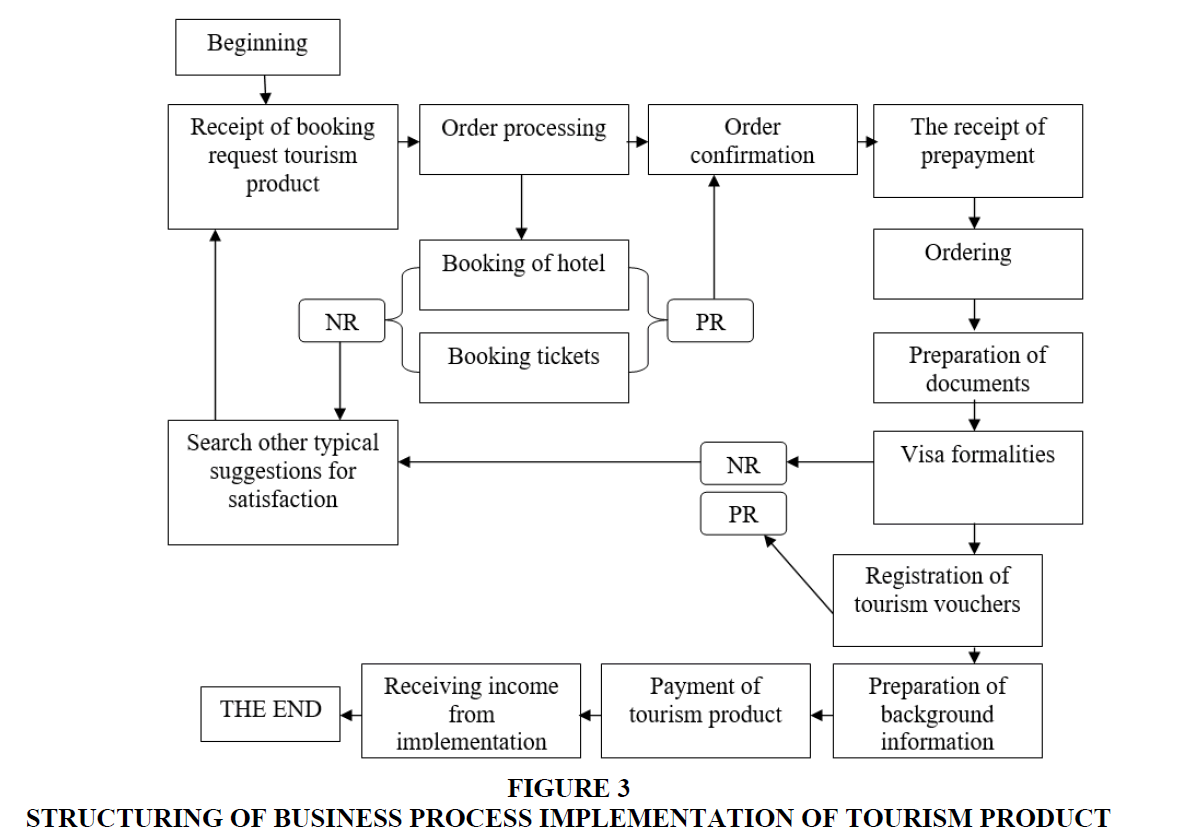Research Article: 2020 Vol: 24 Issue: 1S
Features of Business Processes Model Building in the Field of International Tourism Business
Mykola Serbov, Odessa State Environmental University
Svitlana Korol, Kyiv National Trade Economic University
Aytakin Hasan gizi Akhundova, Baku State University, Azerbaijan
Volodymyr Onopriienko, Sumy National Agrarian University
Abstract
The article is devoted to the scientific question of the combination of management technologies and model building of business processes and the sphere of tourism business. There are investigated and highlighted the main business processes in the sphere of tourism business and considered the main process of business processes in a tourism company. It is defined the algorithm of business processes model building in the sphere of tourism business. It has been formed a business model for the implementation of the tourism product.
Keywords
Tourism Business, International Tourism, Process Approach, Business Processes, Tourism Product, Model Building Algorithm.
Introduction
The urgent problem is problem of gaining and maintaining leadership in the market sector for the practice of business activity in the field of international tourism. The entrepreneur’s goal can be formulated as improving business efficiency, creating a balanced system of resource management. Achieving goal is often difficult because of time losses that increase costs without creating added value. It arises from the inconsistency of management decisions, especially considering the long-term prospective, the absence of operational monitoring system of indicators efficiency of business processes in the organization of the implementation process of the tourism product. Thus, we state that one of the ways to improve the efficiency of business activity in the field of international tourism is the ability to manage internal business processes, analyze and improve them.
Methodology
Methodological framework the study is based on “management theory” according to which the management process is a way of communicating systems in which one system (management subject) affects another (management object) in the purpose to elicit the appropriate response required to adapt to the environment. Another element of methodology is the process approach, according to which all business activity is divided into autonomous business processes according to the criterion of maximum assistance in achieving goals. Each structural unit in the business model should ensure the implementation of specific business processes in which it participates, increases the efficiency of activity in general with a process approach to management.
Literature Review
The theoretical basis of the research is the scientific research and practical developments of famous scientists (Matsusaka, 2001; Myers et al., 2012), devoted to the problems of process management, analysis, optimization of business processes of companies and entrepreneurs. Significant contribution to the development of the concept of process management carried out (Davenport, 1993; Harrington, 1991) who introduced the concept of “improving business processes” and providing practical recommendations on the application of techniques and methods of change and design of business processes. There are devoted to the works research on the implementation of business processes in the field of international tourism (Glaesser, 2006; Seidel et al., 2012; Drobyazko, et al., 2019). But some questions of the essence of business processes and the application of process-oriented approach in tourism business activity remain unexplored, because economic transformation requires the creation of new approaches and solutions.
Findings and discussions
Theoretical Grounds of Management Process in the Activity of Business Structures
Business process management is the process of applying specific techniques, methods, measures to purposefully influence the functioning of the business process, namely ensuring the effective implementation of a set of operations to obtain a high level of economic benefits.
It is necessary to consider the features of this type of activity to isolate the specifics of business processes in the sphere of tourism business and specific features of the management. So, let’s consider the rotation of implementation of the main business processes in the field of tourism business (Figure 1).
Figure 1:The Rotation Of Implementation Of The Main Business Processes In The Field Of Tourism Business
The main business processes in the field of tourism business are aimed at creating a tourism product (Tang, 2015). The process of the design and preparation for implementation requires a significant amount of resources (human, material, financial, information, etc).
The Design of the Tourism Product
The process of designing a tourism product begins with monitoring the consumers’ needs and finding ways to meet them. Tourism product design encompasses a significant number of business processes and sub-processes within a single business process. Most business processes in the field of tourism business focuses on the search of suppliers of tourism services (placement organizations, transport companies) and the process of forming a tourism product (development of tours). The specificity of the business process aimed at the implementation of the tourism product is manifested in the differentiation of travel companies into travel operators and travel agents (Hall, 2008). The first, in turn, directly form the tourism product and can independently implement it; travel agencies by the nature of the activity are engaged only in the sale of tourism products of various travel operators under pre-concluded contracts. It is possible to create a list on the basis of certain features of the business processes implementation, which is inherent in the travel company, reflects the features and distinguishes it from the totality of other companies (Budeanu et al., 2016). We define the main differences in the formation of the tourism product and present them graphically in Figure 2.
So, from Figure 2, we conclude that tour operators are suppliers of tourism products for travel agencies, the latter, in turn, act as an intermediary between the travel operator and the potential consumer of the tourism product. Travel agency is a full-fledged participant, consisting of an interconnected set of business-processes that ensure the coordinated work at the same time.
Model Building Algorithm of Business Processes in the Field of Tourism Business
Considerable attention is paid to the process and methods of model building (description) of business processes as part of the management technology. Several methods are used for model building business processes, the basis of which is a structural and objective-oriented approach to model building. Let’s consider several methods of model building business processes that are most suitable for the specifics of work in the field of tourism business. SADT method (Structured Analysis and Design Technique) is considered a classic method of process approach to management. The main principle of method is to structure the activity of the tourism company, considering the business processes and without taking into account the organizational structure. According to this principle, the business model is proposed to be divided into four main levels:
The 1st level reflects the interaction of the entrepreneur with the processes of the external environment;
The 2-d level describes the main types of commercial business activity of the entrepreneur and the relationship;
The 3-d level details business processes, dividing them into elementary operations, grouped by certain features;
The 4th level describes algorithms for performing elementary functions.
The expediency of using this method to make a business model in the field of tourism business is manifested in the possibility of detailing individual business functions, since this principle ensures the orderly execution of individual operations and prevents the chaotic nature. There is a tendency to integrate a variety of model building business processes methods, one of which is the ARIS (Architecture of Integrated Information System) method at this stage.
ARIS system is a complex of analysis instruments and model building activity. The process of model building business processes covers all aspects of the business structure activity, as each process is considered separately, and then creates an integrated model, that reflects the relationship between all business processes (Karpenko et. al. 2018). The ARIS method consists of a set of diagrams, which elements are specific blocks describing specific objects. Each object of the ARIS system has attributes that provide possibility of detailing individual processes (Table 1).
| Table 1: List Of Objects Of Aris System For Model Building Business Processes In The Field Of Tourism Business | ||
| No | Name of the object | Description (purpose) |
|---|---|---|
| 1 | Function | It is used to describe the functions (works, procedures) performed by subdivisions\staff of the enterprise |
| 2 | Event | It is a description of the actual events that affect the execution of functions |
| 3 | Organizational unit | Characterizes the individual organizational units of the enterprise (management, department) |
| 4 | Document | Reflects the real media |
| 5 | Application system | Displays the actual system that supports and provides the execution of functions |
| 6 | Information cluster | Characterizes data (as a set of entities and relationships between them) used to establish model parameters |
| 7 | Connection | Describes the type of relationship between objects |
| 8 | Logical operator | The operator of one of three types (“and”, “or” excluding “or”) which defines the relationship between events and functions within the process, allows to describe the branching of the process. |
Therefore, this method allows to create a business model of business structure, which connects the links, which in the usual description are non-contiguous. The application of the above methods of model building business processes in the activity of tourism enterprises, will provide the following advantages:
1. regularity of business processes in the field of tourism business;
2. clear distribution of individual business processes into sub-processes with the establishment of the relationship between them;
3. identification of weak links in the business process and the elimination;
4. establishing a logical sequence between the operations (actions, procedures, functions) of the business process;
5. building process-oriented activity of the enterprise.
Particular importance for ensuring the effectiveness of the business process in the model building is the distribution of responsibilities between the executors and the coherence of the execution, since the final result depends on the quality of execution of duties by individual executors. This process of differentiation of duties can be called structuring. Each type of work in a separate business process is accompanied by a certain level of complexity and the degree of execution of one type of work directly affects the other, because all works in the business process are interdependent.
The Business Model is the Sale of Tourism Product
It is created a business model to determine the advantages and disadvantages of a business process, which is a formalized (graphical, tabular, text, symbolic) description of the business process, reflecting the actual or possible eventual outcome. Complex models are used to analyze the business process, which are built on the basis of specialized software in practice (Makedon et al., 2019).
That is why it is advisable to develop an approach that will describe and analyze business processes to management staff, which will greatly facilitate the identification and elimination of deficiencies in the implementation of individual business processes (Figure 3). So, we offer such sequence of the business process description:
1. Setting initial parameters, i.e definition of the purpose and main tasks of business processes implementation. These can be meeting the needs of consumers in tourism services, obtaining economic benefits, improving the competitiveness of the enterprise, etc.
2. Detailing a business process into separate operations is a description of the operations and procedures list that together form a separate business process. This description allows to determine the necessary resources for the implementation of the business process, which in the future makes it possible to minimize excessive spending.
3. Identifying possible lacks and finding alternatives to eliminate them is the process of identifying and predicting a negative result or imperfect implementation of individual sub-processes, which will further affect the final indicators. That is why timely identification of negative options for operations and the creation of preconditions for the elimination increases the likelihood of satisfaction with the results of the business process.
4. Structuring of business processes based on the construction of a graphical image, as the graphical way of presenting information is convenient for perception and reflects the entire structure of operations and possible consequences.
5. Analysis of each individual operation, identification of auxiliary and priority actions, which helps to optimize the business process by eliminating unnecessary procedures.
6. The formation of the expected final result is the definition and establishment of the necessary effect level, which stimulates the search for appropriate ways to implement operations within a separate business process.
Recommendations
We can see recommendations for article that a detailed description of the business process allows us to consider a set of interrelated sub-processes and identify and prevent possible negative result of separate sub-process that will affect the quality and duration of the business process in general. The methods of structuring business processes allow to analyze and eliminate negative consequences, which contributes to the creation of the necessary pre-conditions for the rational and effective functioning of business processes in the field of tourism business.
Conclusion
Thus, we have proved that the business model in the field of tourism business consists of a set of individual business processes, and the success of the business as whole depends on how effective they are. Continuous monitoring and analysis of business processes makes it possible to find reserves to improve efficiency of activity. Studies have shown that the subjects of tourism business do not carry out the regulation of business processes and analyze the effectiveness. It causes a number of problems associated with low manageability activity. These problems are exacerbated and cause negative results in conditions of crisis phenomena. The system vision of increasing the effectiveness of business processes should be based on the direct improvement of functional business processes; development of business processes management instruments; development of methods for efficiency valuation of business processes.
References
- Budeanu, A., Miller, G., Moscardo, G., & Ooi, C.S. (2016). Sustainable tourism, progress, challenges and opportunities: An introduction. Journal of Cleaner Production, 111(5), 285-294.
- Davenport, T.H. (1993). Business Innovation, Reengineering Work through Information Technology. Boston: Harvard Business School Press
- Drobyazko, S., Alieksieienko, I., Kobets, M., Kiselyova, E., & Lohvynenko, M. (2019). Transnationalisation and segment security of the international labor market. Journal of Security and Sustainability Issues 9(2).
- Glaesser, D. (2006). Crisis Management in the Tourism Industry, Elsevier, Oxford.
- Hall, C.M. (2008). Tourism Planning: Policies, Processes and Relationships. 2nd Edn., Pearson/Prentice Hall, Harlow, England, New York
- Harrington, H.J. (1991). Business process improvement: The breakthrough strategy for total quality, productivity. McGrawHill
- Karpenko, L., Serbov, M., Kwilinski, A., Makedon, V. & Drobyazko, S. (2018). Methodological platform of the control mechanism with the energy saving technologies. Academy of Strategic Management Journal, 17(5).
- Makedon, V., Drobyazko, S., Shevtsova, H., Maslosh, O., & Kasatkina, M. (2019). Providing security for the development of high-technology organizations. Journal of Security and Sustainability Issues, 8(4), 1313-1331.
- Matsusaka, J.G. (2001). Corporate Diversification, Value Maximization and Organizational Capabilities. Journal of Business, 74(3), 409-431
- Myers, P., Hulks, S., & Wiggins, L. (2012). Organizational change: Perspectives on theory and practice, Oxford, Oxford University Press
- Seidel, S., Recker, J., & Vom Brocke, J. (2012). Green business process management: Towards the sustainable enterprise. Heidelberg: Springer
- Tang, Z. (2015). An integrated approach to evaluating the coupling coordination between tourism and the environment. Tourism Management, 46(1), 11-19.


